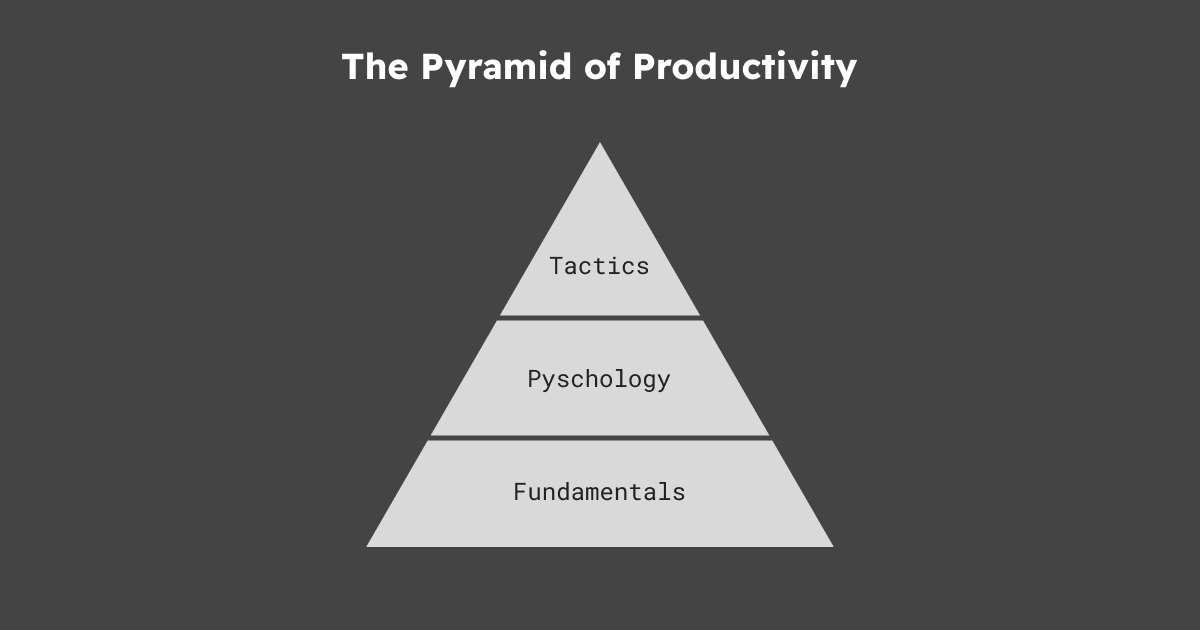Quit Collecting Hammers
Focus on the big wins using the Pyramid of Productivity
In one of the latest episodes of Deep Dive with Ali Abdal interviewing Tiago Forte, they talk about productivity geeks who like hopping on different to-do and note-taking apps. They used a metaphor during their conversation:
Instead of being carpenters, many people become hammer collectors.
Many people spend all their time testing and playing with multiple productivity apps—hoping to find the perfect one—rather than sticking to a good enough tool and focusing on getting the job done.
It's spot on! And that's why I don't share a lot about the latest productivity apps because I don't think we need many of them.
All you need are a to-do list, a calendar, and somewhere to take notes. You can even find a tool with all these functionalities in one place, such as Notion and Coda. And no, they don't need to be digital. You can use a pen and paper if that works for you.
I only look for a new app when I have a specific problem that the current app doesn't solve. And when I found one, I spend a week or two testing it intensely to decide if I want to make a complete switch. And I rarely talk about it unless I've made a complete switch and used it for a few months.
If you've read my past work, you know I've been using Notion for a long time. I started using Obsidian for note-taking around the end of 2020. This year, I added Cron as my calendar and scheduling tools after the one I used discontinued its service.
Another reason you shouldn't spend too much time on the next promising productivity app is that they have little to no impact on your output—unless they change how you see and do things fundamentally. If you're being honest, they rarely move the needle. So instead of looking for the next perfect app, focus on the big wins.
And to understand where big wins come from, I would like to introduce you to the pyramid of productivity I first heard from Ramit Sethi.

The pyramid of productivity comes in three layers.
- The bottom layer is the fundamentals. It's about your sleep, movements, and diet—that directly impact your physiology and hence, your energy level. When your energy levels are low, you are less likely to perform at your best.
- The second layer in the middle is your psychology. It's your beliefs and mental models around work, time, and life. What you believe and how you think about our work affect everything from your motivation to get started to your endurance to stay on course. It makes the same work meaningful for one person but meaningless for another.
- The third layer—and also the tip of the pyramid—are the tactics. These are the productivity tips, tricks, apps, and tools that help you do more in less time.
Like any pyramid, it needs to have a solid base for other things to build on top of it. That said, the biggest wins come from the base, and we start to see diminishing returns as we move our way up on the pyramid.
In terms of productivity, the base is all about energy management, the next is mind management, and the tip is time management. Unfortunately, most productivity apps are designed to help us manage our time instead of our energy and mind.
So if you're serious about performing at your best, quit looking for the next perfect productivity app. Instead, start designing the environment and routines to get better sleep, move well, and keep a balanced diet. Then, take every opportunity to study and work with high performers to figure out how they think and work.


